Residential Battery Energy Storage System Market Size 2024-2028
The residential battery energy storage system market size is forecast to increase by USD 6.24 billion, at a CAGR of 23.02% between 2023 and 2028.
Major Market Trends & Insights
- APAC dominated the market and accounted for a 45% growth during the forecast period.
- By the Type - Lithium-ion segment was valued at USD 1.55 billion in 2022
- By the Power Rating - 6-10 kW segment accounted for the largest market revenue share in 2022
Market Size & Forecast
- Market Opportunities: USD 363.49 million
- Market Future Opportunities: USD 6235.65 million
- CAGR : 23.02%
- APAC: Largest market in 2022
Market Summary
- The Residential Battery Energy Storage System (RBESS) market is witnessing significant growth, driven by the increasing adoption of renewable energy sources and the desire for energy independence. According to recent studies, the global RBESS market is projected to reach a value of USD 12.8 billion by 2027, representing a notable increase from its current market size. This expansion is attributed to advancements in battery technology, which have led to improvements in energy density, efficiency, and cost. Moreover, the integration of smart grid technologies and the growing popularity of time-of-use (TOU) pricing schemes are also contributing factors.
- TOU pricing encourages energy consumption during off-peak hours, incentivizing the use of RBESS to store excess energy generated during these periods for later use. Despite these advantages, the high initial cost of RBESS remains a barrier to entry for some consumers. However, as technology advances and economies of scale are achieved, costs are expected to decrease, making RBESS more accessible to a wider audience. Overall, the RBESS market is poised for continued growth, offering substantial opportunities for businesses and investors in the renewable energy sector.
What will be the Size of the Residential Battery Energy Storage System Market during the forecast period?
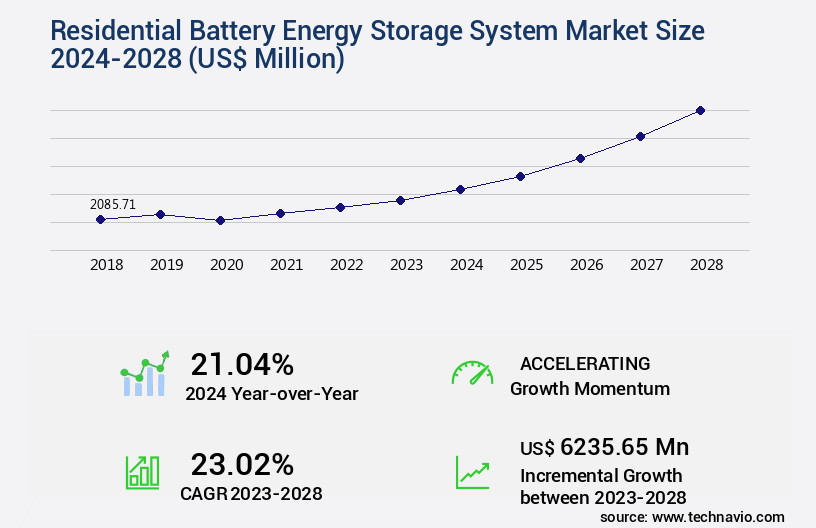
Explore market size, adoption trends, and growth potential for residential battery energy storage system market Request Free Sample
- The market continues to expand, driven by the growing demand for energy efficiency, virtual power plants, and backup power. According to industry estimates, the global market for residential battery energy storage systems is projected to reach USD 12.8 billion by 2027, up from USD3.1 billion in 2020, representing a compound annual growth rate of 21.5%. This growth is fueled by the increasing importance of grid stability and energy autonomy, as well as the ability to shift load, provide voltage support, and offer grid services. Moreover, the integration of advanced features such as smart grid integration, energy resilience, and cost-effective charge control algorithms is enabling energy storage systems to provide significant economic benefits.
- For instance, a homeowner with a 10 kWh battery pack can save approximately USD 1,500 per year on energy bills by using energy storage for peak shaving and emergency power supply. However, the market also faces challenges, including battery degradation modeling, capacity fade, and internal resistance, which can impact power conversion efficiency and system performance over time. Ongoing research in cell balancing, frequency regulation, and cell chemistry is expected to address these challenges and drive further growth in the market.
How is this Residential Battery Energy Storage System Industry segmented?
The residential battery energy storage system industry research report provides comprehensive data (region-wise segment analysis), with forecasts and estimates in "USD million" for the period 2024-2028, as well as historical data from 2018-2022 for the following segments.
- Type
- Power Rating
- Geography
- North America
- Europe
- APAC
- Rest of World (ROW)
By Type Insights
The lithium-ion segment is estimated to witness significant growth during the forecast period.
Lithium-ion residential battery energy storage systems have gained significant traction among homeowners, offering efficient energy usage, grid independence, and renewable energy integration. These systems incorporate advanced technologies such as fault detection systems, load leveling, and grid-tied inverters to optimize energy production and consumption. Lithium-ion batteries, with their high energy density, long cycle life, and fast charging capabilities, are the backbone of these systems. The market for lithium-ion residential battery energy storage is expanding, with solar panel pairing and home energy management becoming increasingly popular. According to recent studies, the market for energy storage systems is projected to reach 12.5% of total renewable energy capacity by 2025.
Furthermore, demand charge reduction and power outage protection are significant drivers for the adoption of these systems. Battery safety standards, such as fire suppression systems and thermal management systems, ensure the safety and longevity of lithium-ion batteries. Overcharge protection, depth of discharge, and battery management systems maintain optimal battery performance and extend battery lifespan. Energy arbitrage and modular battery design offer flexibility and scalability, making these systems an attractive investment for homeowners. The market for lithium-ion residential battery energy storage is expected to grow, with renewable energy integration and smart home integration being key trends. In terms of specific numbers, the market for energy storage systems is projected to reach 19.3% of total renewable energy capacity installations by 2025.
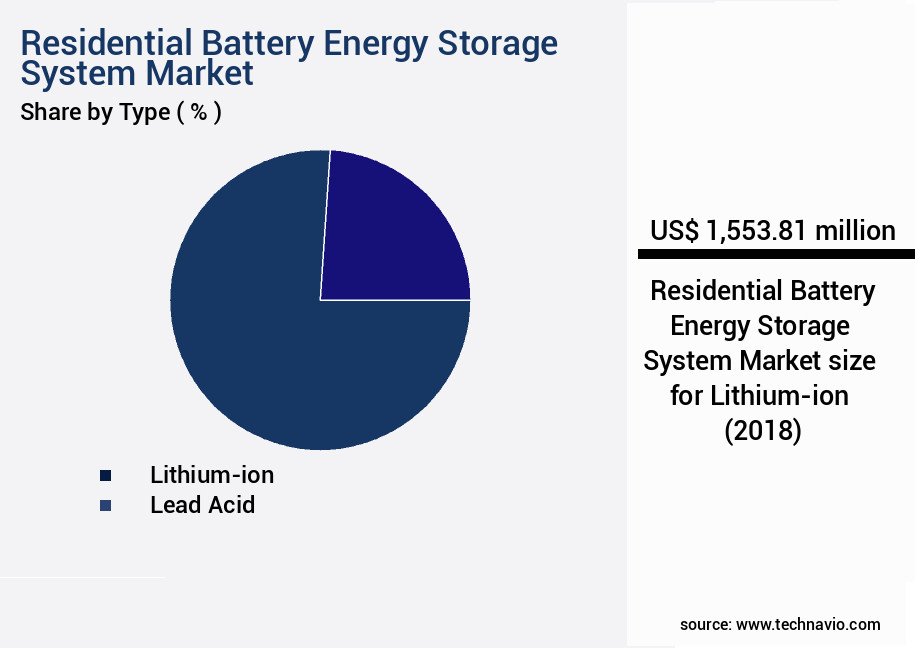
The Lithium-ion segment was valued at USD 1.55 billion in 2018 and showed a gradual increase during the forecast period.
Additionally, the market for residential energy storage systems is expected to reach 30.7% of total energy storage capacity installations by 2025. These systems offer numerous benefits, including peak power output, energy storage capacity, and improved inverter efficiency through power conditioning units. The use of DC-coupled systems and AC-coupled systems further enhances the overall performance of these systems. With round-trip efficiency and overdischarge protection, lithium-ion residential battery energy storage systems provide a reliable and efficient solution for homeowners.
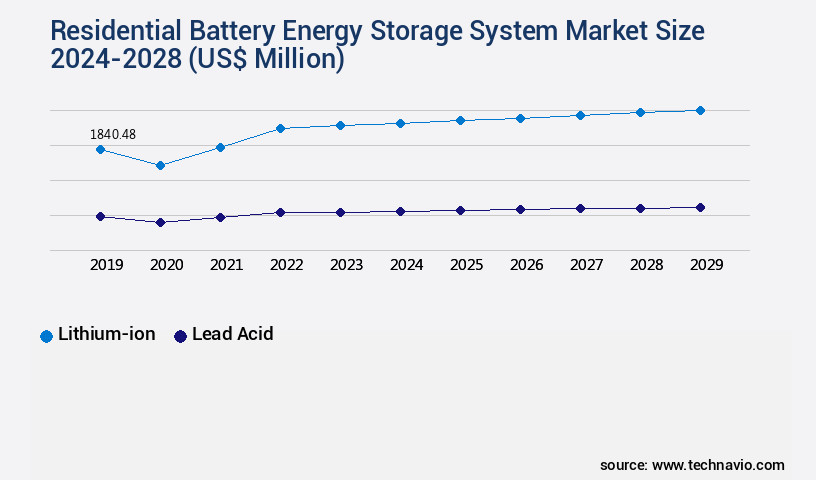
Request Free Sample
Regional Analysis
APAC is estimated to contribute 45% to the growth of the global market during the forecast period. Technavio's analysts have elaborately explained the regional trends and drivers that shape the market during the forecast period.

See How Residential Battery Energy Storage System Market Demand is Rising in APAC Request Free Sample
The European power sector is undergoing significant transformations, driven by advancements in technology, the integration of information and communications technology (ICT), shifting consumer preferences, and the European Climate Change Programme. Renewable energy adoption is on the rise in Europe, contributing to a low-carbon power generation mix. This trend is primarily fueled by government initiatives like the European Union Emissions Trading Scheme (ETS), the world's first and largest greenhouse gas emissions trading system. According to recent studies, the European residential battery energy storage system (REBS) market is expected to grow substantially. For instance, the market share of REBS in the overall energy storage market is projected to reach approximately 40% by 2027, up from around 25% in 2020.
Moreover, the total installed capacity of REBS in Europe is anticipated to expand at a remarkable pace, growing from around 5 GW in 2020 to over 25 GW by 2027. A comparison of market data reveals that the adoption rate of REBS in Europe is increasing at a faster pace than in other regions. For instance, the compound annual growth rate (CAGR) of the European REBS market is projected to be around 25% between 2020 and 2027, compared to 18% in Asia Pacific and 15% in North America during the same period. This rapid growth can be attributed to the supportive regulatory environment, increasing electricity prices, and the availability of incentives for renewable energy adoption in Europe.
In conclusion, the European power sector is experiencing a shift towards renewable energy and low-carbon power generation. The market is a significant contributor to this trend, with substantial growth expected in the coming years. The market is anticipated to reach a significant market share and capacity in Europe, driven by supportive regulatory frameworks, increasing electricity prices, and incentives for renewable energy adoption.
Market Dynamics
Our researchers analyzed the data with 2023 as the base year, along with the key drivers, trends, and challenges. A holistic analysis of drivers will help companies refine their marketing strategies to gain a competitive advantage.
Optimizing Residential Energy Storage Systems: Performance, Compliance, and Innovation The residential battery energy storage market in the US is witnessing significant growth, driven by the need for energy independence, grid reliability, and cost savings. Lithium iron phosphate batteries are gaining popularity due to their long lifespan and safety features, which improve system reliability and reduce the total cost of ownership. Properly sizing residential energy storage systems is crucial for maximizing performance and efficiency. Battery management system algorithms play a vital role in optimizing battery performance and ensuring safe operation. Grid-tied inverters can benefit from efficiency optimization techniques, while power electronics converter designs enhance overall system performance. Home energy management system integration and solar panel and battery system synchronization enable time-of-use pricing strategies, allowing homeowners to save on energy costs. Demand charge reduction strategies and energy arbitrage using residential storage further boost savings potential. Battery thermal management strategies and degradation modeling techniques ensure optimal battery performance and longevity. Safety standards, such as UL 9540A and UL 1973, ensure residential battery storage systems meet stringent safety requirements. Modular battery systems offer scalability, enabling easy expansion as energy storage needs grow. AC coupled vs DC coupled energy storage systems have their unique advantages, and understanding these differences is essential for selecting the optimal solution. Predictive maintenance for battery systems and remote diagnostics enable early identification and resolution of potential issues, minimizing downtime and maintenance costs. Virtual power plant participation and microgrid energy storage applications offer new revenue streams and increased grid resilience. Innovations in battery technology, such as advanced battery chemistries and smart grid integration, continue to shape the residential energy storage market, offering new opportunities for businesses and homeowners alike.
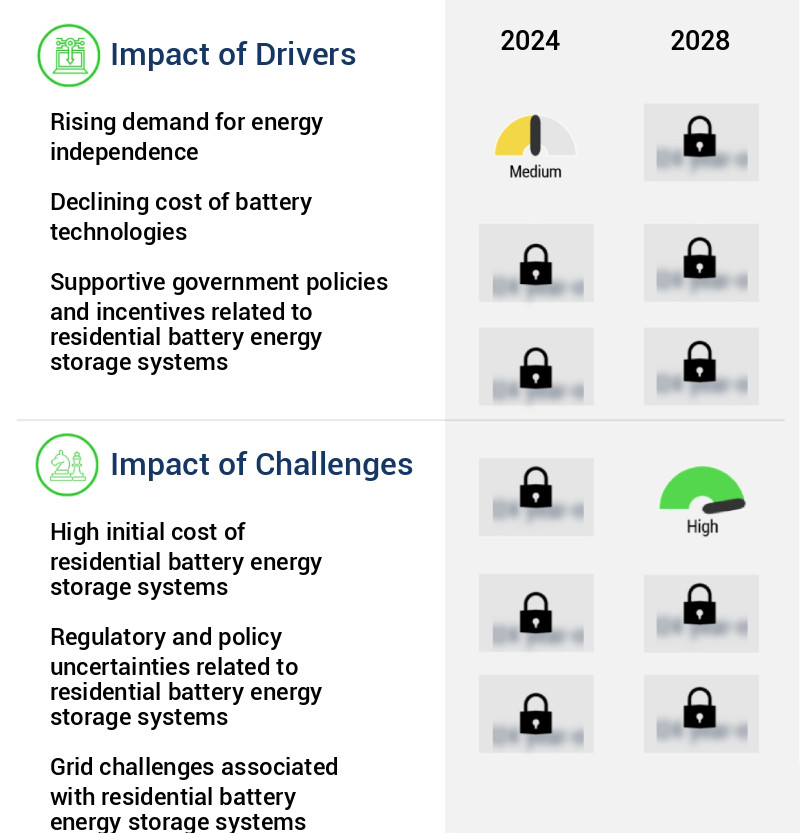
What are the key market drivers leading to the rise in the adoption of Residential Battery Energy Storage System Industry?
- The surge in demand for energy independence serves as the primary market catalyst.
- The residential battery energy storage market experiences continuous expansion as homeowners increasingly prioritize energy independence and self-consumption. Battery energy storage systems integrate seamlessly with renewable energy sources, such as solar PV systems, to store excess energy generated during peak production. This stored energy can then be utilized during periods of high demand or when the grid is unavailable. The integration of battery energy storage systems with renewable energy sources enables homeowners to reduce their reliance on traditional energy grids and gain greater control over their energy consumption. The benefits of energy independence extend beyond cost savings, as these systems provide a more sustainable energy solution and contribute to the reduction of greenhouse gas emissions.
- The market's evolution is driven by advancements in battery technology, which have led to increased energy density, longer cycle life, and lower costs. Additionally, government incentives and subsidies aimed at promoting renewable energy adoption further fuel market growth. According to recent market data, the global residential battery energy storage market is expected to witness significant growth, with the number of installations projected to increase at a remarkable pace. In comparison to traditional energy storage systems, residential battery energy storage systems offer a more cost-effective solution for energy storage and consumption. The market's dynamic nature is further underscored by the ongoing development of smart grid technologies, which enable the integration of battery energy storage systems into the power grid.
- This integration allows for the optimization of energy distribution and consumption, ultimately benefiting both homeowners and utility companies. In conclusion, the residential battery energy storage market represents a compelling investment opportunity for homeowners seeking energy independence and control over their energy consumption. The market's continuous growth is driven by advancements in battery technology, government incentives, and the integration of smart grid technologies.
What are the market trends shaping the Residential Battery Energy Storage System Industry?
- The trend in the residential energy market is shifting towards technological advancements in battery energy storage systems. Advancements in technology are driving the residential battery energy storage market forward.
- The market is experiencing significant growth, fueled by continuous technological advancements. Innovations in battery chemistry and materials are enhancing energy density, cycle life, and safety, allowing homeowners to store more energy in smaller footprints and achieve longer battery lifespans. Leading companies, such as Tesla Inc., are at the forefront of this development, investing heavily in research and development to produce high-performance lithium-ion battery cells for residential applications. This innovation drives the value proposition of these systems, enabling homeowners to store renewable energy for later use and reduce reliance on traditional power sources. The market's evolution is not limited to battery technology; it also encompasses the integration of smart grid technologies and energy management systems, which optimize energy consumption and distribution.
- As a result, residential battery energy storage systems are increasingly becoming a cost-effective and sustainable solution for households, particularly those with renewable energy installations. The market's growth is expected to continue as technological advancements unfold, providing homeowners with more efficient, reliable, and cost-effective energy storage solutions.
What challenges does the Residential Battery Energy Storage System Industry face during its growth?
- The high initial cost of residential battery energy storage systems represents a significant challenge to the industry's growth trajectory. This financial hurdle hinders widespread adoption and limits the expansion of the market for these systems.
- The residential battery energy storage market experiences ongoing evolution, driven by advancements in technology and increasing demand for renewable energy solutions. Homeowners seek energy independence and cost savings, fueling the market's growth. However, the high initial cost of residential battery energy storage systems remains a significant barrier, with prices ranging from USD 5,000 to USD 15,000 or more in the US. This cost variation depends on factors like battery capacity, brand, installation complexity, and additional equipment requirements, such as inverters and monitoring systems. Despite the initial investment, the benefits of energy storage, including energy cost savings, backup power, and grid support, make it an attractive proposition for homeowners.
- The market continues to unfold, with manufacturers and installers exploring innovative financing models to make energy storage more accessible. As technology advances and economies of scale are achieved, the cost of residential battery energy storage systems is expected to decline further, making them a more viable option for a broader consumer base.
Exclusive Customer Landscape
The residential battery energy storage system market forecasting report includes the adoption lifecycle of the market, covering from the innovator's stage to the laggard's stage. It focuses on adoption rates in different regions based on penetration. Furthermore, the residential battery energy storage system market report also includes key purchase criteria and drivers of price sensitivity to help companies evaluate and develop their market growth analysis strategies.
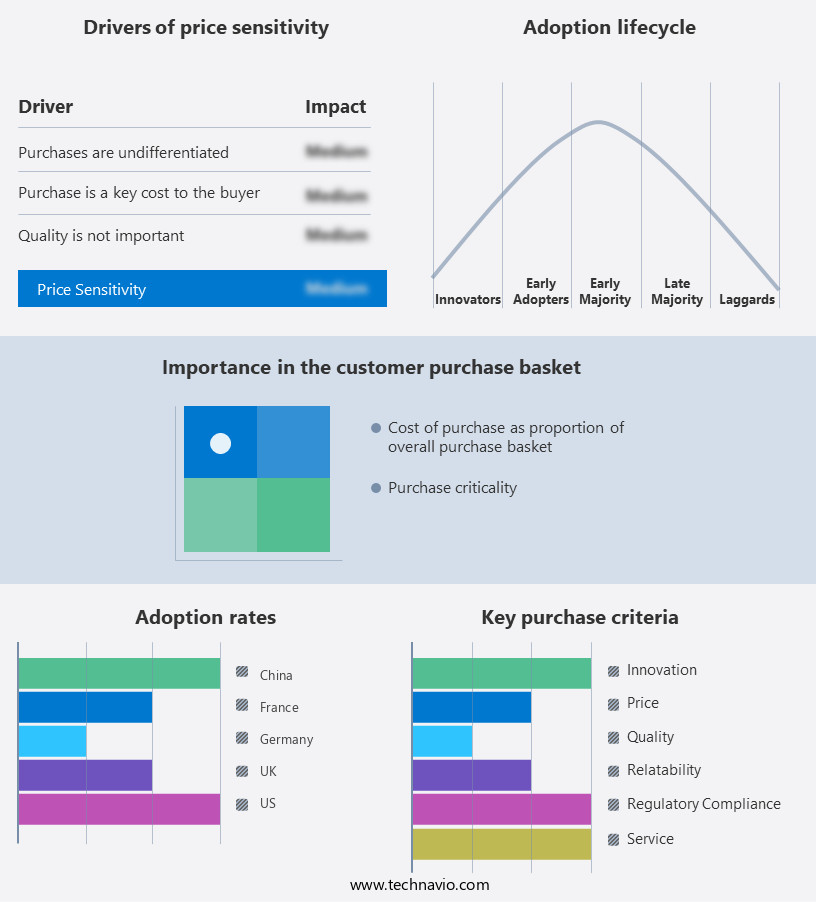
Customer Landscape of Residential Battery Energy Storage System Industry
Key Companies & Market Insights
Companies are implementing various strategies, such as strategic alliances, residential battery energy storage system market forecast, partnerships, mergers and acquisitions, geographical expansion, and product/service launches, to enhance their presence in the industry.
ABB Ltd. - The company specializes in providing residential battery energy storage solutions, including the SMILE G3 5kW 10.1kWh and SMILE G3 5kW 20.2kWh systems.
The industry research and growth report includes detailed analyses of the competitive landscape of the market and information about key companies, including:
- ABB Ltd.
- Alpha ESS Co., Ltd.
- Blue Planet Energy
- Briggs and Stratton LLC
- BYD Co. Ltd.
- C and D Technologies Inc.
- East Penn Manufacturing Co. Inc.
- Eaton Corp. Plc
- Enphase Energy Inc.
- Fortress Power
- Generac Holdings Inc.
- Growatt New Energy Technology Co., Ltd.
- LG Corp.
- Panasonic Holdings Corp.
- Samsung Electronics Co. Ltd.
- Schneider Electric SE
- Shell plc
- SMA Solar Technology AG
- SolarEdge Technologies Inc.
- SolaX Power Network Technology Zhejiang Co. Ltd.
- Sunrun Inc.
- Tesla Inc.
- Victron Energy BV
Qualitative and quantitative analysis of companies has been conducted to help clients understand the wider business environment as well as the strengths and weaknesses of key industry players. Data is qualitatively analyzed to categorize companies as pure play, category-focused, industry-focused, and diversified; it is quantitatively analyzed to categorize companies as dominant, leading, strong, tentative, and weak.
Recent Development and News in Residential Battery Energy Storage System Market
- In January 2024, Tesla, a leading energy technology company, announced the expansion of its Powerwall residential battery energy storage system lineup with the new Powerwall 3. This advanced lithium-ion battery offers increased energy density, longer life cycle, and lower cost per kilowatt-hour compared to its predecessor (Tesla Press Release, 2024).
- In March 2024, LG Chem, a major global battery manufacturer, formed a strategic partnership with SunPower, a solar panel producer, to integrate LG Chem's RESU battery series with SunPower's solar systems. This collaboration aims to provide integrated solar and energy storage solutions to residential customers, enhancing the efficiency and reliability of renewable energy systems (LG Chem Press Release, 2024).
- In May 2024, Sunrun, a leading residential solar and energy storage company, raised USD300 million in a Series F funding round, led by BlackRock. This investment will support Sunrun's expansion into new markets, product development, and the deployment of its Brightbox residential energy storage system (Sunrun Press Release, 2024).
- In February 2025, the European Union announced the 'REPowerEU' initiative, which includes a € 300 billion investment plan to accelerate the transition to renewable energy and energy efficiency. This initiative is expected to significantly boost the demand for residential battery energy storage systems across Europe (European Commission Press Release, 2025).
Research Analyst Overview
- The market is witnessing significant growth and innovation, driven by the increasing demand for clean, reliable, and cost-effective energy solutions. One of the primary applications of these systems is demand charge reduction, which enables homeowners to shave their electricity usage during peak hours, thereby reducing their energy bills. Lithium-ion batteries are the dominant technology in the residential energy storage market due to their high energy density, long cycle life, and scalability.
- Home energy management systems (HEMS) are increasingly being integrated with battery energy storage systems to optimize energy usage and provide real-time monitoring and control. Modular battery designs and fire suppression systems are also gaining popularity due to their safety features and ability to accommodate varying energy requirements. Scalability is a crucial factor in the residential battery energy storage market, as systems must be able to accommodate growing energy demands and integrate with renewable energy sources such as solar panels. Thermal management systems, overcharge protection, and depth of discharge are essential considerations in ensuring the longevity and efficiency of these batteries.
- Energy arbitrage, or the practice of buying energy when it is cheap and selling it back to the grid when it is expensive, is another application of residential battery energy storage systems. Inverter efficiency, power conditioning units, and AC coupled systems are essential components in facilitating this energy trading. Battery safety standards are a critical concern in the residential energy storage market, with organizations such as Underwriters Laboratories (UL) and the International Electrotechnical Commission (IEC) setting guidelines for battery design, installation, and maintenance. These standards ensure the safety and reliability of battery energy storage systems, providing peace of mind for homeowners and utilities alike.
Dive into Technavio's robust research methodology, blending expert interviews, extensive data synthesis, and validated models for unparalleled Residential Battery Energy Storage System Market insights. See full methodology.
|
Market Scope
|
|
Report Coverage
|
Details
|
|
Page number
|
174
|
|
Base year
|
2023
|
|
Historic period
|
2018-2022 |
|
Forecast period
|
2024-2028
|
|
Growth momentum & CAGR
|
Accelerate at a CAGR of 23.02%
|
|
Market growth 2024-2028
|
USD 6235.65 million
|
|
Market structure
|
Fragmented
|
|
YoY growth 2023-2024(%)
|
21.04
|
|
Key countries
|
US, China, Germany, UK, and France
|
|
Competitive landscape
|
Leading Companies, Market Positioning of Companies, Competitive Strategies, and Industry Risks
|
Request Free Sample
What are the Key Data Covered in this Residential Battery Energy Storage System Market Research and Growth Report?
- CAGR of the Residential Battery Energy Storage System industry during the forecast period
- Detailed information on factors that will drive the growth and forecasting between 2024 and 2028
- Precise estimation of the size of the market and its contribution of the industry in focus to the parent market
- Accurate predictions about upcoming growth and trends and changes in consumer behaviour
- Growth of the market across Europe, APAC, North America, Middle East and Africa, and South America
- Thorough analysis of the market's competitive landscape and detailed information about companies
- Comprehensive analysis of factors that will challenge the residential battery energy storage system market growth of industry companies
We can help! Our analysts can customize this residential battery energy storage system market research report to meet your requirements.
Get in touch
1 Executive Summary
- 1.1 Market overview
- Exhibit 01: Executive Summary – Chart on Market Overview
- Exhibit 02: Executive Summary – Data Table on Market Overview
- Exhibit 03: Executive Summary – Chart on Global Market Characteristics
- Exhibit 04: Executive Summary – Chart on Market by Geography
- Exhibit 05: Executive Summary – Chart on Market Segmentation by Type
- Exhibit 06: Executive Summary – Chart on Market Segmentation by Power Rating
- Exhibit 07: Executive Summary – Chart on Incremental Growth
- Exhibit 08: Executive Summary – Data Table on Incremental Growth
- Exhibit 09: Executive Summary – Chart on Vendor Market Positioning
2 Market Landscape
- 2.1 Market ecosystem
- Exhibit 10: Parent market
- Exhibit 11: Market Characteristics
3 Market Sizing
- 3.1 Market definition
- Exhibit 12: Offerings of vendors included in the market definition
- 3.2 Market segment analysis
- Exhibit 13: Market segments
- 3.4 Market outlook: Forecast for 2023-2028
- Exhibit 14: Chart on Global - Market size and forecast 2023-2028 ($ million)
- Exhibit 15: Data Table on Global - Market size and forecast 2023-2028 ($ million)
- Exhibit 16: Chart on Global Market: Year-over-year growth 2023-2028 (%)
- Exhibit 17: Data Table on Global Market: Year-over-year growth 2023-2028 (%)
4 Historic Market Size
- 4.1 Global residential battery energy storage system market 2018 - 2022
- Exhibit 18: Historic Market Size – Data Table on global residential battery energy storage system market 2018 - 2022 ($ million)
- 4.2 Type Segment Analysis 2018 - 2022
- Exhibit 19: Historic Market Size – Type Segment 2018 - 2022 ($ million)
- 4.3 Power rating Segment Analysis 2018 - 2022
- Exhibit 20: Historic Market Size – Power rating Segment 2018 - 2022 ($ million)
- 4.4 Geography Segment Analysis 2018 - 2022
- Exhibit 21: Historic Market Size – Geography Segment 2018 - 2022 ($ million)
- 4.5 Country Segment Analysis 2018 - 2022
- Exhibit 22: Historic Market Size – Country Segment 2018 - 2022 ($ million)
5 Five Forces Analysis
- 5.1 Five forces summary
- Exhibit 23: Five forces analysis - Comparison between 2023 and 2028
- 5.2 Bargaining power of buyers
- Exhibit 24: Chart on Bargaining power of buyers – Impact of key factors 2023 and 2028
- 5.3 Bargaining power of suppliers
- Exhibit 25: Bargaining power of suppliers – Impact of key factors in 2023 and 2028
- 5.4 Threat of new entrants
- Exhibit 26: Threat of new entrants – Impact of key factors in 2023 and 2028
- 5.5 Threat of substitutes
- Exhibit 27: Threat of substitutes – Impact of key factors in 2023 and 2028
- 5.6 Threat of rivalry
- Exhibit 28: Threat of rivalry – Impact of key factors in 2023 and 2028
- 5.7 Market condition
- Exhibit 29: Chart on Market condition - Five forces 2023 and 2028
6 Market Segmentation by Type
- 6.1 Market segments
- Exhibit 30: Chart on Type - Market share 2023-2028 (%)
- Exhibit 31: Data Table on Type - Market share 2023-2028 (%)
- 6.2 Comparison by Type
- Exhibit 32: Chart on Comparison by Type
- Exhibit 33: Data Table on Comparison by Type
- 6.3 Lithium-ion - Market size and forecast 2023-2028
- Exhibit 34: Chart on Lithium-ion - Market size and forecast 2023-2028 ($ million)
- Exhibit 35: Data Table on Lithium-ion - Market size and forecast 2023-2028 ($ million)
- Exhibit 36: Chart on Lithium-ion - Year-over-year growth 2023-2028 (%)
- Exhibit 37: Data Table on Lithium-ion - Year-over-year growth 2023-2028 (%)
- 6.4 Lead acid - Market size and forecast 2023-2028
- Exhibit 38: Chart on Lead acid - Market size and forecast 2023-2028 ($ million)
- Exhibit 39: Data Table on Lead acid - Market size and forecast 2023-2028 ($ million)
- Exhibit 40: Chart on Lead acid - Year-over-year growth 2023-2028 (%)
- Exhibit 41: Data Table on Lead acid - Year-over-year growth 2023-2028 (%)
- 6.5 Market opportunity by Type
- Exhibit 42: Market opportunity by Type ($ million)
- Exhibit 43: Data Table on Market opportunity by Type ($ million)
7 Market Segmentation by Power Rating
- 7.1 Market segments
- Exhibit 44: Chart on Power Rating - Market share 2023-2028 (%)
- Exhibit 45: Data Table on Power Rating - Market share 2023-2028 (%)
- 7.2 Comparison by Power Rating
- Exhibit 46: Chart on Comparison by Power Rating
- Exhibit 47: Data Table on Comparison by Power Rating
- 7.3 6-10 kW - Market size and forecast 2023-2028
- Exhibit 48: Chart on 6-10 kW - Market size and forecast 2023-2028 ($ million)
- Exhibit 49: Data Table on 6-10 kW - Market size and forecast 2023-2028 ($ million)
- Exhibit 50: Chart on 6-10 kW - Year-over-year growth 2023-2028 (%)
- Exhibit 51: Data Table on 6-10 kW - Year-over-year growth 2023-2028 (%)
- 7.4 3-6 kW - Market size and forecast 2023-2028
- Exhibit 52: Chart on 3-6 kW - Market size and forecast 2023-2028 ($ million)
- Exhibit 53: Data Table on 3-6 kW - Market size and forecast 2023-2028 ($ million)
- Exhibit 54: Chart on 3-6 kW - Year-over-year growth 2023-2028 (%)
- Exhibit 55: Data Table on 3-6 kW - Year-over-year growth 2023-2028 (%)
- 7.5 10-20 kW - Market size and forecast 2023-2028
- Exhibit 56: Chart on 10-20 kW - Market size and forecast 2023-2028 ($ million)
- Exhibit 57: Data Table on 10-20 kW - Market size and forecast 2023-2028 ($ million)
- Exhibit 58: Chart on 10-20 kW - Year-over-year growth 2023-2028 (%)
- Exhibit 59: Data Table on 10-20 kW - Year-over-year growth 2023-2028 (%)
- 7.6 Market opportunity by Power Rating
- Exhibit 60: Market opportunity by Power Rating ($ million)
- Exhibit 61: Data Table on Market opportunity by Power Rating ($ million)
8 Customer Landscape
- 8.1 Customer landscape overview
- Exhibit 62: Analysis of price sensitivity, lifecycle, customer purchase basket, adoption rates, and purchase criteria
9 Geographic Landscape
- 9.1 Geographic segmentation
- Exhibit 63: Chart on Market share by geography 2023-2028 (%)
- Exhibit 64: Data Table on Market share by geography 2023-2028 (%)
- 9.2 Geographic comparison
- Exhibit 65: Chart on Geographic comparison
- Exhibit 66: Data Table on Geographic comparison
- 9.3 Europe - Market size and forecast 2023-2028
- Exhibit 67: Chart on Europe - Market size and forecast 2023-2028 ($ million)
- Exhibit 68: Data Table on Europe - Market size and forecast 2023-2028 ($ million)
- Exhibit 69: Chart on Europe - Year-over-year growth 2023-2028 (%)
- Exhibit 70: Data Table on Europe - Year-over-year growth 2023-2028 (%)
- 9.4 APAC - Market size and forecast 2023-2028
- Exhibit 71: Chart on APAC - Market size and forecast 2023-2028 ($ million)
- Exhibit 72: Data Table on APAC - Market size and forecast 2023-2028 ($ million)
- Exhibit 73: Chart on APAC - Year-over-year growth 2023-2028 (%)
- Exhibit 74: Data Table on APAC - Year-over-year growth 2023-2028 (%)
- 9.5 North America - Market size and forecast 2023-2028
- Exhibit 75: Chart on North America - Market size and forecast 2023-2028 ($ million)
- Exhibit 76: Data Table on North America - Market size and forecast 2023-2028 ($ million)
- Exhibit 77: Chart on North America - Year-over-year growth 2023-2028 (%)
- Exhibit 78: Data Table on North America - Year-over-year growth 2023-2028 (%)
- 9.6 Middle East and Africa - Market size and forecast 2023-2028
- Exhibit 79: Chart on Middle East and Africa - Market size and forecast 2023-2028 ($ million)
- Exhibit 80: Data Table on Middle East and Africa - Market size and forecast 2023-2028 ($ million)
- Exhibit 81: Chart on Middle East and Africa - Year-over-year growth 2023-2028 (%)
- Exhibit 82: Data Table on Middle East and Africa - Year-over-year growth 2023-2028 (%)
- 9.7 South America - Market size and forecast 2023-2028
- Exhibit 83: Chart on South America - Market size and forecast 2023-2028 ($ million)
- Exhibit 84: Data Table on South America - Market size and forecast 2023-2028 ($ million)
- Exhibit 85: Chart on South America - Year-over-year growth 2023-2028 (%)
- Exhibit 86: Data Table on South America - Year-over-year growth 2023-2028 (%)
- 9.8 US - Market size and forecast 2023-2028
- Exhibit 87: Chart on US - Market size and forecast 2023-2028 ($ million)
- Exhibit 88: Data Table on US - Market size and forecast 2023-2028 ($ million)
- Exhibit 89: Chart on US - Year-over-year growth 2023-2028 (%)
- Exhibit 90: Data Table on US - Year-over-year growth 2023-2028 (%)
- 9.9 China - Market size and forecast 2023-2028
- Exhibit 91: Chart on China - Market size and forecast 2023-2028 ($ million)
- Exhibit 92: Data Table on China - Market size and forecast 2023-2028 ($ million)
- Exhibit 93: Chart on China - Year-over-year growth 2023-2028 (%)
- Exhibit 94: Data Table on China - Year-over-year growth 2023-2028 (%)
- 9.10 Germany - Market size and forecast 2023-2028
- Exhibit 95: Chart on Germany - Market size and forecast 2023-2028 ($ million)
- Exhibit 96: Data Table on Germany - Market size and forecast 2023-2028 ($ million)
- Exhibit 97: Chart on Germany - Year-over-year growth 2023-2028 (%)
- Exhibit 98: Data Table on Germany - Year-over-year growth 2023-2028 (%)
- 9.11 UK - Market size and forecast 2023-2028
- Exhibit 99: Chart on UK - Market size and forecast 2023-2028 ($ million)
- Exhibit 100: Data Table on UK - Market size and forecast 2023-2028 ($ million)
- Exhibit 101: Chart on UK - Year-over-year growth 2023-2028 (%)
- Exhibit 102: Data Table on UK - Year-over-year growth 2023-2028 (%)
- 9.12 France - Market size and forecast 2023-2028
- Exhibit 103: Chart on France - Market size and forecast 2023-2028 ($ million)
- Exhibit 104: Data Table on France - Market size and forecast 2023-2028 ($ million)
- Exhibit 105: Chart on France - Year-over-year growth 2023-2028 (%)
- Exhibit 106: Data Table on France - Year-over-year growth 2023-2028 (%)
- 9.13 Market opportunity by geography
- Exhibit 107: Market opportunity by geography ($ million)
- Exhibit 108: Data Tables on Market opportunity by geography ($ million)
10 Drivers, Challenges, and Trends
- 10.3 Impact of drivers and challenges
- Exhibit 109: Impact of drivers and challenges in 2023 and 2028
11 Vendor Landscape
- 11.2 Vendor landscape
- Exhibit 110: Overview on Criticality of inputs and Factors of differentiation
- 11.3 Landscape disruption
- Exhibit 111: Overview on factors of disruption
- 11.4 Industry risks
- Exhibit 112: Impact of key risks on business
12 Vendor Analysis
- 12.1 Vendors covered
- Exhibit 113: Vendors covered
- 12.2 Market positioning of vendors
- Exhibit 114: Matrix on vendor position and classification
- 12.3 Alpha ESS Co., Ltd.
- Exhibit 115: Alpha ESS Co., Ltd. - Overview
- Exhibit 116: Alpha ESS Co., Ltd. - Product / Service
- Exhibit 117: Alpha ESS Co., Ltd. - Key offerings
- 12.4 Briggs and Stratton LLC
- Exhibit 118: Briggs and Stratton LLC - Overview
- Exhibit 119: Briggs and Stratton LLC - Product / Service
- Exhibit 120: Briggs and Stratton LLC - Key offerings
- 12.5 BYD Co. Ltd.
- Exhibit 121: BYD Co. Ltd. - Overview
- Exhibit 122: BYD Co. Ltd. - Business segments
- Exhibit 123: BYD Co. Ltd. - Key news
- Exhibit 124: BYD Co. Ltd. - Key offerings
- Exhibit 125: BYD Co. Ltd. - Segment focus
- 12.6 Eaton Corp. Plc
- Exhibit 126: Eaton Corp. Plc - Overview
- Exhibit 127: Eaton Corp. Plc - Business segments
- Exhibit 128: Eaton Corp. Plc - Key offerings
- Exhibit 129: Eaton Corp. Plc - Segment focus
- 12.7 Enphase Energy Inc.
- Exhibit 130: Enphase Energy Inc. - Overview
- Exhibit 131: Enphase Energy Inc. - Product / Service
- Exhibit 132: Enphase Energy Inc. - Key offerings
- 12.8 Generac Holdings Inc.
- Exhibit 133: Generac Holdings Inc. - Overview
- Exhibit 134: Generac Holdings Inc. - Business segments
- Exhibit 135: Generac Holdings Inc. - Key offerings
- Exhibit 136: Generac Holdings Inc. - Segment focus
- 12.9 Growatt New Energy Technology Co., Ltd.
- Exhibit 137: Growatt New Energy Technology Co., Ltd. - Overview
- Exhibit 138: Growatt New Energy Technology Co., Ltd. - Product / Service
- Exhibit 139: Growatt New Energy Technology Co., Ltd. - Key offerings
- 12.10 LG Corp.
- Exhibit 140: LG Corp. - Overview
- Exhibit 141: LG Corp. - Business segments
- Exhibit 142: LG Corp. - Key offerings
- Exhibit 143: LG Corp. - Segment focus
- 12.11 Panasonic Holdings Corp.
- Exhibit 144: Panasonic Holdings Corp. - Overview
- Exhibit 145: Panasonic Holdings Corp. - Product / Service
- Exhibit 146: Panasonic Holdings Corp. - Key news
- Exhibit 147: Panasonic Holdings Corp. - Key offerings
- 12.12 Samsung Electronics Co. Ltd.
- Exhibit 148: Samsung Electronics Co. Ltd. - Overview
- Exhibit 149: Samsung Electronics Co. Ltd. - Business segments
- Exhibit 150: Samsung Electronics Co. Ltd. - Key news
- Exhibit 151: Samsung Electronics Co. Ltd. - Key offerings
- Exhibit 152: Samsung Electronics Co. Ltd. - Segment focus
- 12.13 Shell plc
- Exhibit 153: Shell plc - Overview
- Exhibit 154: Shell plc - Business segments
- Exhibit 155: Shell plc - Key news
- Exhibit 156: Shell plc - Key offerings
- Exhibit 157: Shell plc - Segment focus
- 12.14 SMA Solar Technology AG
- Exhibit 158: SMA Solar Technology AG - Overview
- Exhibit 159: SMA Solar Technology AG - Business segments
- Exhibit 160: SMA Solar Technology AG - Key offerings
- Exhibit 161: SMA Solar Technology AG - Segment focus
- 12.15 SolaX Power Network Technology Zhejiang Co. Ltd.
- Exhibit 162: SolaX Power Network Technology Zhejiang Co. Ltd. - Overview
- Exhibit 163: SolaX Power Network Technology Zhejiang Co. Ltd. - Product / Service
- Exhibit 164: SolaX Power Network Technology Zhejiang Co. Ltd. - Key offerings
- 12.16 Sunrun Inc.
- Exhibit 165: Sunrun Inc. - Overview
- Exhibit 166: Sunrun Inc. - Product / Service
- Exhibit 167: Sunrun Inc. - Key news
- Exhibit 168: Sunrun Inc. - Key offerings
- 12.17 Tesla Inc.
- Exhibit 169: Tesla Inc. - Overview
- Exhibit 170: Tesla Inc. - Business segments
- Exhibit 171: Tesla Inc. - Key news
- Exhibit 172: Tesla Inc. - Key offerings
- Exhibit 173: Tesla Inc. - Segment focus
13 Appendix
- 13.2 Inclusions and exclusions checklist
- Exhibit 174: Inclusions checklist
- Exhibit 175: Exclusions checklist
- 13.3 Currency conversion rates for US$
- Exhibit 176: Currency conversion rates for US$
- 13.4 Research methodology
- Exhibit 177: Research methodology
- Exhibit 178: Validation techniques employed for market sizing
- Exhibit 179: Information sources
- 13.5 List of abbreviations
- Exhibit 180: List of abbreviations







![]() Get the report (PDF) sent to your email within minutes.
Get the report (PDF) sent to your email within minutes.
Complimentary full Excel data with your report purchase.